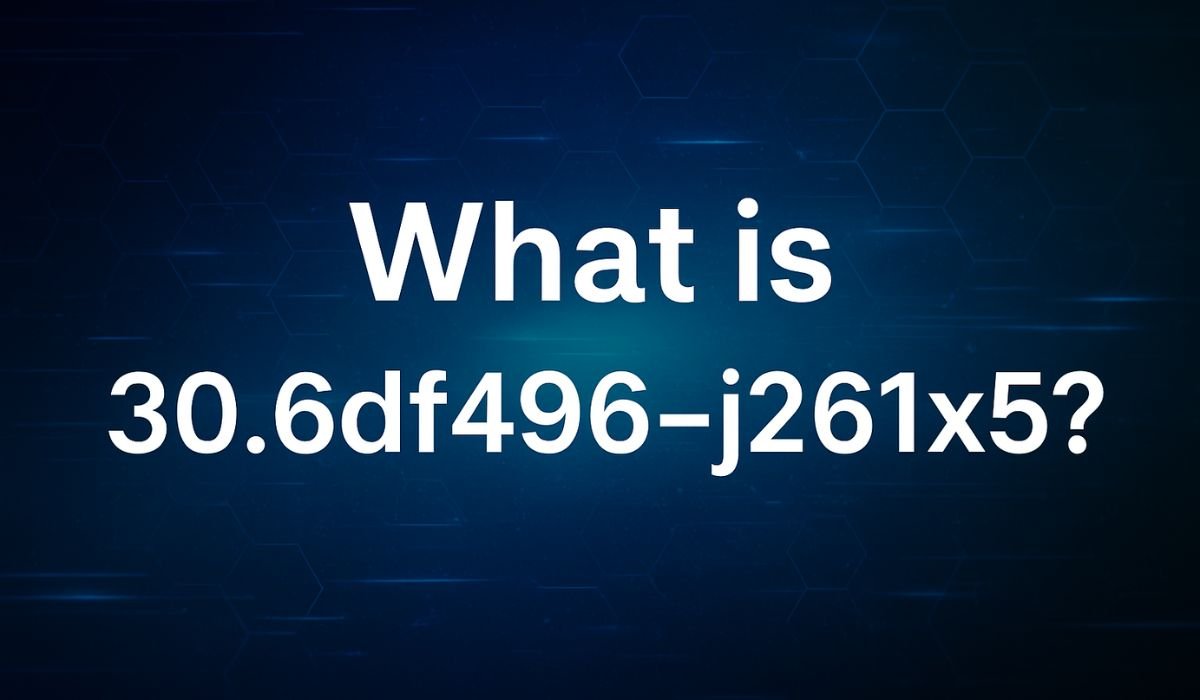In today’s interconnected digital universe, identifiers play a crucial, yet sometimes invisible role, in how systems, applications, and databases communicate with one another. If you are signing into an online service, downloading an update to a software application, or tracking an order, there is almost always a type of identifier tying it together. One of the more interesting identifiers is 30.6df496–j261x5. While at first glance 30.6df496–j261x5 could appear to be an arbitrary random string, upon deeper examination it will be clear that identifiers exist as systems, they are purposeful, meaningful, and structured.
So, what is 30.6df496–j261x5? This blog will give an overview of identifiers, their potential structure, their uses in different industries, their usefulness and limitations, and where identifiers will go in the future. Ultimately, you will see that while it may seem random to you and I, identifiers are part of the largely invisible framework that helps maintain and parallel our digital world and our physical world.
What is 30.6df496–j261x5?
In simple terms, 30.6df496–j261x5 is an alphanumeric identifier. Identifiers like these are prevalent in technology-oriented systems to identify, label, track, and distinguish between various objects, processes, or versions. The segments of the identifier should be interpreted as having potential meaning.
For example:
- 30 could be a version number or a surrogate prefix for collated data to identify species or similar items.
- 6df496 looks like a hexadecimal value. Perhaps from a hashing criterion or system-generated unique identifier.
- j261x5 may be a user session identifier, or some reference to a component, or an internal module number.
All of this denotes the identifier wasn’t random and likely structured for a purpose. When you say “what is 30.6df496–j261x5” effectively you are saying “what is the logic behind structured identifiers in general, and why does this matter?”
Why Identifiers Like 30.6df496–j261x5 Exist
If we use plain words only to label every dataset, product or software version, the systems would soon face issues like duplication, confusion and inefficiency. For example, if all datasets were called “data1”,” data2” and so on, confusion would ensue due to overlaps.
Identifiers like 30.6df496–j261x5 solve these challenges in four ways:
- They provide uniqueness; no two things can share the same identifier.
- They provide machine readability; systems are able to simply store information, process information and validate codes.
- They reduce errors; identifiers are more structured in their ability to reduce errors of mixing files or products.
- They enable scale; as organizations evolve from handling hundreds to millions of items, identifiers help the organization add items without disorganization.
Ultimately, when someone asks what is 30.6df496–j261x5, the reality is it is a scalable systematic way to label anything within a digital or logistical environment.
Breaking Down the Structure of 30.6df496–j261x5
Identifiers may appear to be complex, but most follow an element of logic. Let’s break this example down:
- 30 → This could refer to a major version, release cycle, or product line.
- 6df496 → This is a hexadecimal string most commonly associated with cryptographic identifiers, data hashing, and/or database entries.
- j261x5 → This is a combination of letters and numbers, probably referring to a sub-module, session id, or an internal sequence.
An identifier with this format would be sufficiently unique and unguessable thus feasible for applying to secure systems.
Read More: MP E Uparjan Portal || MP Bhulekh Ekyc || MP e District Portal 2025
Where Identifiers Like 30.6df496–j261x5 Are Used
Now that we have a clearer sense of what is 30.6df496–j261x5, let’s examine real-world areas where identifiers of this type play a vital role:
1. Software Development and Version Control
Developers constantly work with identifiers similar to 30.6df496–j261x5 to track builds, commits, and releases. Every time a new feature or update is deployed, a unique identifier ensures that there is no conflict with older versions. Without such identifiers, modern collaborative software development would be chaotic.
2. Data Management Systems
In the world of databases, identifiers are indispensable. Codes like 30.6df496–j261x5 help distinguish between multiple versions of a dataset, track modifications, or retrieve specific records quickly. For analysts and businesses dealing with vast amounts of data, this kind of precision is non-negotiable.
3. Inventory and Logistics
Think of supply chains that span continents. A simple label like “Box A” would be meaningless at scale. Instead, structured codes like 30.6df496–j261x5 tag shipments, product batches, or containers, making tracking efficient and universal. This boosts accuracy and minimizes errors in inventory management.
4. Digital Security and Authentication
Security tokens, API keys, and session IDs often resemble the format of 30.6df496–j261x5. Because they are unique and nearly impossible to guess, they add a strong layer of protection to online systems. For example, when you log into a service, an identifier like this may be working behind the scenes to validate your session.
Benefits of Using Identifiers Like 30.6df496–j261x5

The advantages of identifiers extend far beyond convenience:
- Uniqueness – Every item, user, or process can be represented without overlap.
- Privacy Protection – Randomized identifiers shield sensitive details from exposure.
- Machine Efficiency – They are lightweight, easy to generate, and quick to process.
- Scalability – Businesses can grow without worrying about naming conflicts.
When people ask what is 30.6df496–j261x5, one of the best answers is that it represents a bridge between complexity and clarity, making it possible for systems to operate seamlessly.
The Challenges of Complex Identifiers
Despite their many strengths, identifiers like 30.6df496–j261x5 are not perfect. Some common drawbacks include:
- Human Unreadability: To the average person, they appear random and hard to memorize.
- Need for Documentation: Without a reference guide, it’s nearly impossible to know what each section means.
- Typing Errors: Manually entering identifiers can lead to mistakes, which is why scannable formats such as QR codes or barcodes are often paired with them.
These challenges highlight that identifiers are meant more for machines than humans, which is both a strength and a limitation.
How Identifiers Like 30.6df496–j261x5 Are Generated
There are several ways systems generate identifiers of this type:
- Random Generators – Codes are created using algorithms that select numbers and letters at random.
- Hash Functions – Fixed-length codes are generated from input data, ensuring consistency and uniqueness.
- Custom Logic – Some organizations design internal rules for identifier creation based on workflows, product lines, or user sessions.
The method chosen depends on the intended use case. But whether through randomization or structured logic, the outcome is the same: a reliable and unique identifier.
The Future of Identifiers Like 30.6df496–j261x5
As technology continues to evolve, identifiers will become even more critical. Looking ahead, we can expect them to:
- Embed More Information – Identifiers may carry hidden metadata for smarter systems.
- Become More Secure – Stronger cryptographic methods will make them less prone to misuse.
- Integrate with AI – Identifiers will work with artificial intelligence to automate interpretation and tracking.
- Standardize Globally – Cross-platform identifiers will emerge to unify systems across industries.
So, when asking what is 30.6df496–j261x5 in the future, the answer may be even more sophisticated, as identifiers continue to evolve into smarter and more interactive digital keys.
Conclusion
To the average observer, 30.6df496–j261x5 may appear to be an arbitrary and meaningless string of characters. However, as we have seen, it is so much more: it is a structured identifier that benefits machines while still ensuring that it is unique, private, scalable, and efficient on a digital scale, and it serves as a representation of that uniqueness across many systems. Whether you are engaging in software development, database management, supply chain tracking, or online security, identifiers like this one are a silent force behind modern technology.
So, the next time you encounter what is 30.6df496–j261x5, ask yourself if it is a version label, or dataset identifier, shipment label, or a secure session key. It is a small yet powerful brick in the interdependent digital infrastructure that we all rely on everywhere we go. Absolutely not arbitrary or meaningless, 30.6df496–j261x5 represents order, precision, and dependability when scale and security are paramount.




